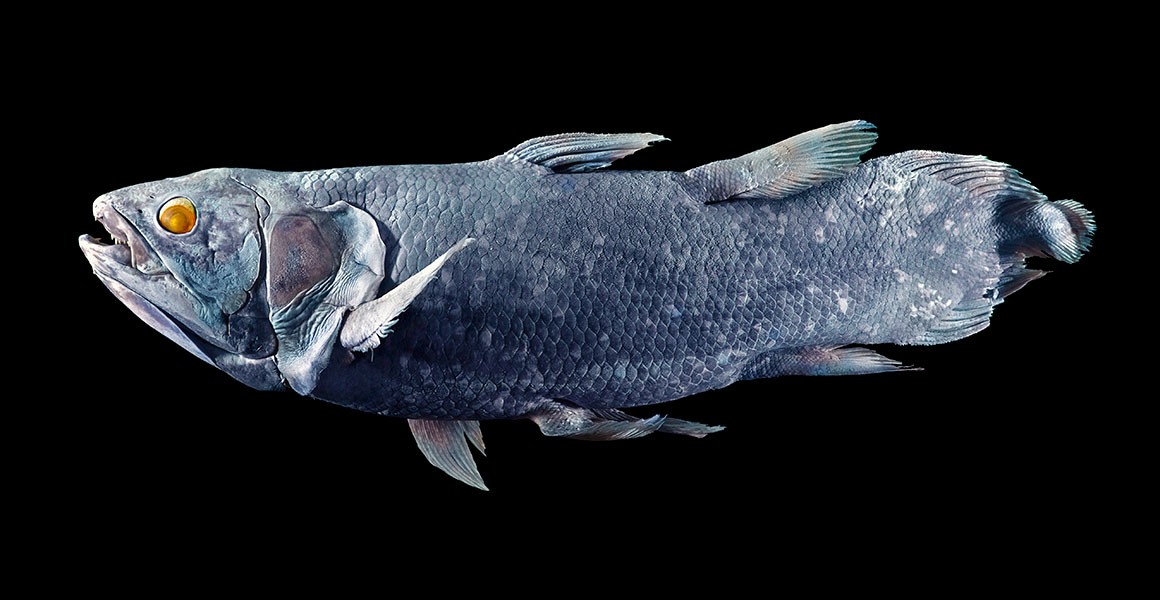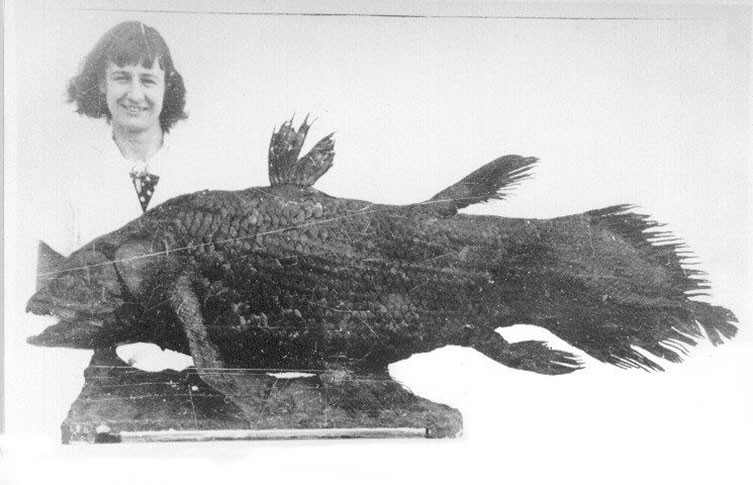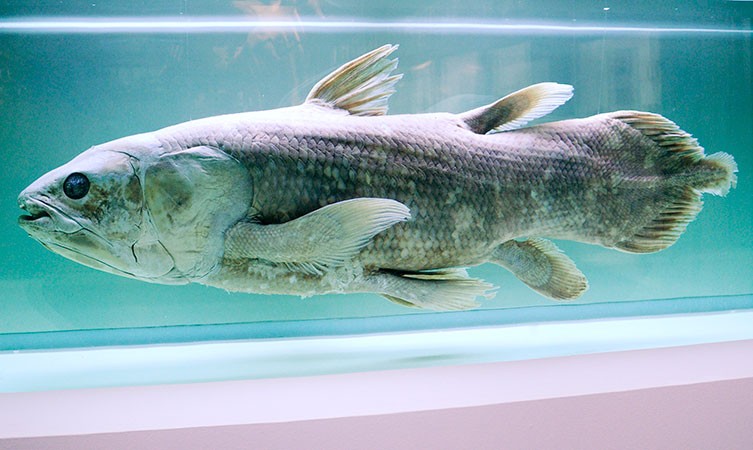Create a list of articles to read later. You will be able to access your list from any article in Discover.
You don't have any saved articles.

Coelacanths were thought to have been extinct for 70 million years until one was found alive in 1938
The unexpected capture of a living coelacanth in the 1930s was 'the most sensational natural history discovery' of the century.
In April 1939, New Zealand's Auckland Star proclaimed that the Loch Ness monster, a sensation that had caught the world's attention not long prior, had been 'outdone'.
Making up for the world's disappointment that there wasn't a prehistoric creature living in a Scottish loch was the South African discovery of a strange, steel blue fish with limb-like fins.
The fish was a coelacanth, one of a group that was thought to have gone extinct 70 million years earlier. But this one was alive.
On 22 December 1938, Marjorie Courtenay-Latimer, curator of the East London Museum in South Africa, saw a fish unlike any other. It had been caught in a trawl net, and at 1.5 metres long with a vivid blue armour of scales and strange, fleshy fins, it was definitely something special.
To identify her find, Courtenay-Latimer engaged the help of JLB Smith, a fish expert and lecturer at Rhodes University in Makhanda (Grahamstown). When he received her letter in January, Smith was instantly hooked.

Marjorie Courtenay-Latimer, curator of the East London Museum in South Africa, stands beside the coelacanth specimen found in 1938. Image via Wikimedia Commons.
'From your drawing and description the fish resembles forms which have been extinct for many a long year,' he wrote in reply. 'I feel it must be of great scientific value.'
Courtenay-Latimer and Smith's correspondence continued until Smith could visit East London in February and see the specimen for himself.
In his 1956 book Old Fourlegs, he recalled, 'I stood as if stricken to stone. Yes, there was not a shadow of a doubt, scale by scale, bone by bone, fin by fin, it was a true Coelacanth.'
Smith named the fish Latimeria chalumnae after Courtenay-Latimer and its place of capture, the mouth of the Chalumna River.
When it was revealed, the story of the now-living fossil fish made headlines around the world.

A living coelacanth photographed on the KwaZulu-Natal South Coast, South Africa, in 2019 © Bruce A.S. Henderson via Wikimedia commons (CC BY-SA 4.0)
Smith began to search for a second specimen but had to wait until 1952, when Ahmadi Abdulla, a fisherman from the Comoro Islands, 2,000km away, claimed the reward. While it was western science's second recorded living coelacanth, locally the fish was called gombessa, and two to three had been caught each year when night fishing.
The fish was thought so important that a military aircraft was dispatched to retrieve it. The world's attention was captured once again. Even Hollywood was hooked, with the discovery allegedly inspiring the monster from 1954's Creature from the Black Lagoon.
Since 1952, L. chalumnae has been found elsewhere on the east coast of Africa, including in Madagascar, Mozambique and Kenya.

The West Indian Ocean coelacanth specimen, found in 1938, on display at the East London Museum, South Africa © Chris Bloom via Flickr (CC BY-SA 2.0)
Coelacanths were first described by Louis Agassiz in 1836 from a 260-million-year-old fossilised fish tail. He named the genus Coelacanthus. Many more fossil coelacanths have been found since, ranging in age from 409-66 million years old.
The living West Indian Ocean coelacanth reaches up to two metres long and 100 kilograms. It's typically found 90-300 metres below the surface, in waters 18°C and below. The fish shelter in caves during the day and venture out at night to hunt cuttlefish, squid and fish. It has been suggested that they have a lifespan of 100 years.
In 1975, scientists discovered that the fish give birth to live young. Eggs hatch in the female's body, and the pups grow to about 30 centimetres before they are born after a gestation of over a year.

A coelacanth pup on display at a South African Institute for Aquatic Biodiversity exhibition in Makhanda © A3 Baard via Wikimedia Commons (CC BY-SA 4.0)
Coelacanths, extinct and extant, belong to a group known as lobe-finned fishes (Sarcopterygii). They have multiple fleshy, limb-like fins. Before the first expeditions to see them in their natural environment, Smith predicted that coelacanths would use these fins to walk on the sea floor.
But observations show that coelacanths typically drift with the current, their body and tail held rigid. The sail-like first dorsal fin and lobed fins help with stabilisation and turning, and the latter contribute to propulsion as well.
The paired fins move in a coordinated way, unlike in other fishes. The diagonal pelvic and pectoral fins work in tandem, like the leg movement pattern of a walking reptile.
Coelacanths have also been observed performing 'headstands', rotating their body to be vertical in the water and holding this position for several minutes. This behaviour is linked to a rostral organ in the head that is thought to detect the weak electrical impulses of prey.

Coelacanths have fleshy, lobed-fins that look a bit like limbs rather than fins © Citron via Wikimedia Commons (CC BY-SA 3.0)
Adding to the list of unusual characteristics is that the coelacanth is supported by a notochord rather than a robust spine. Coelacanths have a bony skull which has an intracranial joint, a hinge that allows the fish to open its mouth especially wide. This feature isn't seen in any other living vertebrate.
Finding a living coelacanth has been described as like finding a dinosaur wandering around your garden. The youngest known fossil coelacanth is 66 million years old, leading to the assumption that these animals were extinct.
Coelacanths are sometimes called a Lazarus taxon, named for the Biblical Lazarus who was raised from the dead. These are organisms that reappear after a long period of seemingly being extinct. There are two characteristics that Lazarus taxa tend to share: a limited geographic range and a habitat where fossils rarely form.
In the past, coelacanths lived in a variety of habitats including shallow seas, freshwater lakes and rivers, as well as deeper marine areas. Today, coelacanths are particularly tied to deep water volcanic areas, like the Comoros Islands.
Lobe-finned fishes like coelacanths are more closely related to tetrapods than to ray-finned fishes (Actinopterygii), which make up about 99% of the known fish species.
Tetrapods include birds, amphibians, reptiles and mammals. They are four-limbed vertebrates, but also include notable exceptions such as snakes.
Features such as limb-like fins might suggest an animal being on an evolutionary path of moving from living in the water to land. When it was discovered in the 1930s, Latimeria was proclaimed the potential missing link.
A direct link from coelacanths to humans and other tetrapods has since been disproven, however. The late Peter Forey, a coelacanth expert at the Museum, noted in 1990 that we would expect to find the link in freshwater, and that it would likely have a stout vertebral column.

A pencil drawing by Peter Forey depicting two coelacanths, one of which is performing a 'headstand.' This behaviour is thought to help the fish to detect prey using its rostral organ.
The coelacanth, however, is marine and its notochord makes it suited to a life where water supports its body. Other characteristics that don't line up with a missing link include the its breathing system, circulatory system and eyes that are adapted for low light.
In 2013, scientists sequenced the coelacanth genome. Analysis of this and other animals' DNA shows that lungfishes are more closely related to land vertebrates than coelacanths are.
In 1997, almost 60 years after the discovery of the L. chalumnae in South Africa, coelacanths took the world by surprise once again. Thousands of kilometres away, at an outdoor market on the Indonesian island of Sulawesi, Arnaz Mehta Erdmann and her ichthyologist husband Mark Erdmann came across a large brown fish that was instantly recognisable as a coelacanth.
The fish had been caught locally and, as with Smith, the hunt was on for a second specimen. Fishermen knew the animal as raja laut - 'king of the sea' - but it wouldn't be until the following year that another catch was reported.
From DNA analysis, scientists could tell that the Indonesian fish was a different species to L. chalumnae. French ichthyologist Laurent Pouyaud formally named the new species Latimeria menadoensis. Competition was fierce between the teams, with Erdmann declaring the naming a 'dishonourable act of scientific piracy'.
We don't know how many coelacanths there are. A 2011 study estimated that the population of Grande Comore is 300-400 individuals, but other populations are not well known.

Coelacanths have been a lucrative business in the past, but now both species are protected from trade © smerikal via Flickr (CC BY-SA 2.0)
Coelacanths have little value as food and used to be released when caught by fishermen. But when they became of scientific interest, the fish became specifically targeted.
In the past, fishermen in the Comoros Islands were highly rewarded for reporting their coelacanth captures. There was soon no shortage of specimens allowing comprehensive studies to be carried out. Surplus fish also became used as official gifts by the Cormoran Government.
Predicting only a small population of the fish, Smith grew uneasy with the practice of rewarding coelacanth captures, surmising in The Times in 1956 that 'the world would rightly recoil in horror' if a herd of dinosaurs were discovered and there were a policy of rewarding their slaughter.
Coelacanths remained desirable and a lucrative business, however. A black market sprung up and the fish have been highly sought after by aquariums, despite no coelacanth having survived at the surface for more than a few hours after capture.

A painting of coelacanth caught in the Comoro Islands in the 1970s, by Gordon Howes
London Zoo reportedly were willing to spend £1,000 in 1952 to secure a specimen. In 1989 the Toba Aquarium in Japan came under fire for a £1.3 million project to capture live coelacanths. In 1992, two coelacanths appeared on an illegal trade price list at £100,000 each.
The Sulawesi coelacanth is considered vulnerable by the International Union for Conservation of Nature, whereas the West Indian Ocean coelacanth is critically endangered. Both species are now protected from trade by CITES.
Historically, when coelacanth discoveries have been made, a degree of global coelacanth-mania has followed.

In 1939, this drawing of a coelacanth accompanied a column in New Zealand's Auckland Star, titled 'Loch Ness Outdone' © Fairfax Media via National Library of New Zealand (CC BY-NC-SA 3.0 NZ)
But we're not yet at the end of the coelacanth's unusual story. Some have questioned how likely it is that there are just two disjunct strongholds of these strange fish.
The discovery of two silver coelacanth models in Spain in the 1960s, which some experts believe are from seventeenth- or eighteenth-century Mesoamerica, has some casting a potential eye at the waters off central America for new species. Not all are convinced, however.
Others have looked at the genetics of coelacanth populations and suggested there may well be cryptic species (animals that look identical but are genetically distinct species).
There is a question of whether other living coelacanth species exist and, if so, whether we'll ever find them. The mysterious and long-hidden world of the coelacanth is an excellent reminder that we still have a lot to learn about the secrets hidden in our oceans.